Cultural Etiquette and Customs In Siem Reap: Understanding Local Customs and Etiquette is Important for Travelers
July 3, 2023
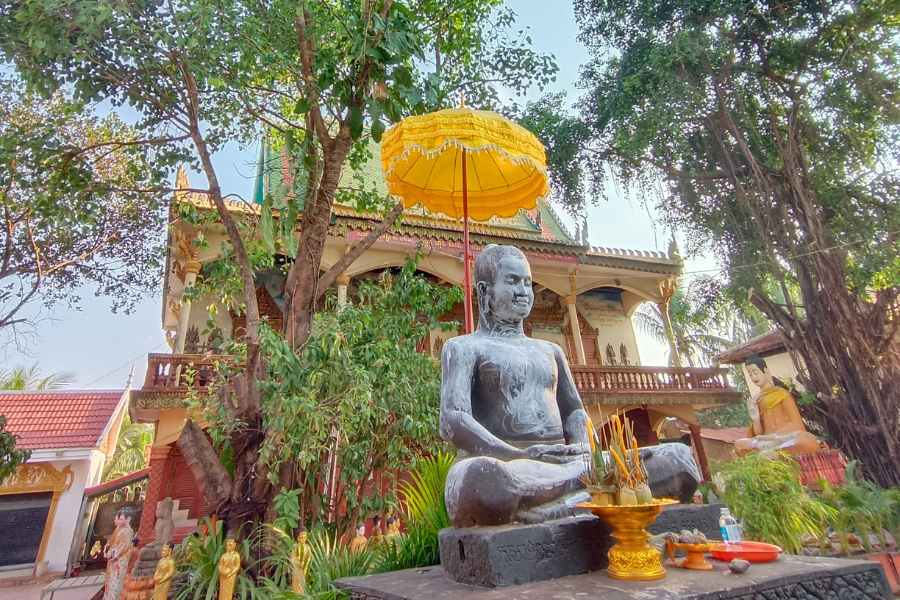
Table of Contents
Cultural Etiquette and Customs In Siem Reap: Understanding Local Customs and Etiquette is Important for Travelers
We examine everything from how to greet people to appropriate dress in temples
Visiting Siem Reap can be a cultural adventure, but understanding local customs and etiquette is key to having an enriching experience. Cambodia’s unique blend of Khmer culture and Buddhism heavily dictates the social norms that travelers should respect.
This article will serve as your guide to navigating these nuances with ease – from the way you greet locals to dressing appropriately in sacred temples. Read on and immerse yourself naturally into the charming rhythm of Siem Reap!
Key Takeaways
- Master the traditional Cambodian greeting known as ‘Sampeah,’ which involves placing your palms together at chest level and giving a slight bow. This gesture is used to say hello, goodbye, thank you, or apologize.
- Show respect for elders by using polite language, avoiding interrupting them, and refraining from physical gestures like touching their heads or crossing their legs while sitting in front of them.
- Dress respectfully when visiting Siem Reap by covering shoulders and knees both in the city and temples. It’s essential to remove shoes before entering temple grounds, avoid pointing feet towards Buddha statues or monks, speak softly inside temples, and follow proper etiquette during religious ceremonies.
- Understand customs such as gift-giving etiquette that emphasizes thoughtfulness over monetary value. Present gifts with two hands, accept gifts graciously even if they’re not what you expected, be mindful of color symbolism when wrapping gifts (avoid white or black), consider bringing small toys or school supplies for children if interacting with them during your trip.
The Facts
- Cambodian etiquette is influenced by Khmer culture and Buddhism.
- Visitors to Cambodia may not be familiar with all of the customs, and the locals are generally understanding and tolerant.
- There are certain dos and don’ts to follow when traveling in Cambodia to show respect for the local customs.
- Dressing modestly is important in Cambodia, and visitors should avoid wearing swimsuits or revealing clothing in towns and temples.
- It is recommended to cover the shoulders and knees when visiting temples in Cambodia.
- Carrying a scarf or sarong to cover up when needed is a good idea.
- The culture of Cambodia is rich in history, traditions, and food.
- It is important to respect Buddhist temples when visiting Southeast Asia and to dress appropriately.
- Many tourists in Southeast Asia may not be aware of the appropriate dress code for temples.
Greetings and Interactions
Properly greeting people and interacting with them in Cambodia is an essential aspect of cultural etiquette.
Proper greetings in Cambodia
Navigating the terrain of Cambodian social etiquette starts with mastering proper greetings. Emulating the locals can aid in forming a connection and showing respect for their culture. The traditional Cambodian greeting, known as ‘Sampeah,’ involves placing your palms together at chest level and giving a slight bow.
This gesture is not only used to say hello but also goodbye, thank you, or even to apologize. Try observing the locals: they use different levels of Sampeah according to age and status – the higher the hands go towards the forehead, the more respect is shown.
Note that handshakes have become common due to Western influence, mostly among men, while women often still prefer ‘Sampeah’. It’s encouraged to return such courtesies when they are extended to enhance cultural immersion during your visit.
Showing respect for elders
In Cambodian culture, showing respect for elders is highly valued and an important aspect of social interactions. It is customary to greet older individuals with a slight bow or folding your hands in a praying gesture, known as “sample.”
This gesture shows reverence and acknowledges their wisdom and experience. When conversing with older people, it’s important to use polite language and avoid interrupting them. Listening attentively and displaying patience are also seen as signs of respect.
In addition to verbal respect, there are certain physical gestures that should be avoided when interacting with elders. Touching someone’s head or patting them on the back may be considered disrespectful, especially towards older individuals.
Crossing your legs while sitting in front of an elder is also discouraged as it can be seen as rude.
Interacting with the opposite sex
In Cambodia, it is important to be aware of cultural norms when interacting with the opposite sex. Cambodian society places a strong emphasis on respect and modesty, especially in public settings.
As a traveler, it’s important to avoid any behavior that may be perceived as inappropriate or disrespectful. This means refraining from physical contact or intimate gestures with someone of the opposite sex unless you have established a close personal relationship.
It is also advisable for men and women to dress modestly and avoid revealing clothing, particularly in temples or religious sites where conservative attire is expected. By being mindful of these cultural customs, you can ensure that your interactions are respectful and culturally sensitive during your time in Siem Reap.
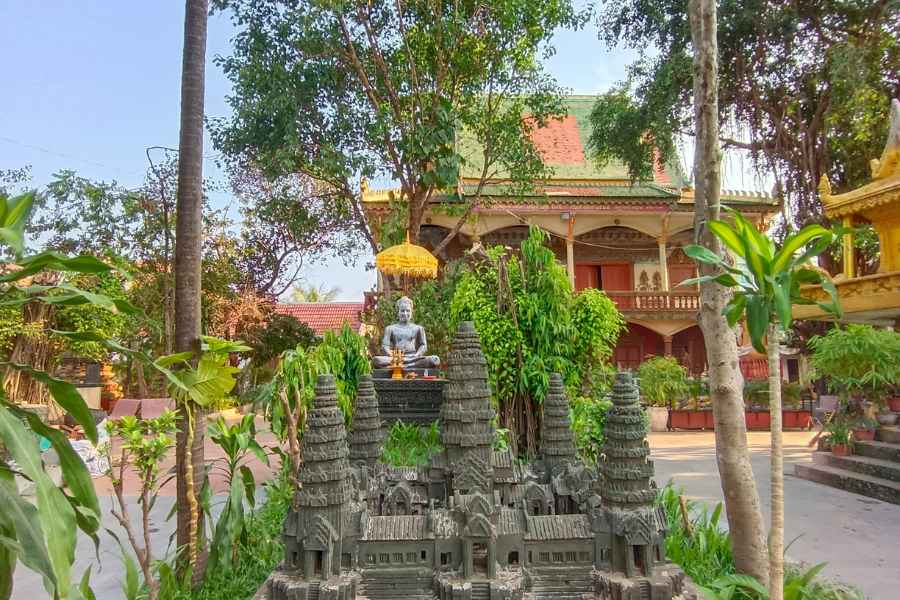
Dress Code and Appropriate Attire
When visiting Siem Reap, it is important to dress respectfully in both the city and temples.
Dressing respectfully in the city
When visiting Siem Reap, it is important to dress respectfully in the city. Cambodia values modesty and conservative attire, so it is best to avoid wearing revealing clothing or swimsuits while exploring town.
Locals appreciate visitors who dress appropriately and show respect for their culture. To adhere to local customs, it is advisable to cover your shoulders and knees when walking around Siem Reap.
By being mindful of your clothing choices, you can fully immerse yourself in the rich cultural experience that this charming city has to offer.
Dressing appropriately in temples
When visiting temples in Siem Reap, it is important to dress appropriately as a sign of respect for the local customs and traditions. Cambodian culture emphasizes modesty, so it is recommended to avoid wearing revealing clothing or swimsuits when entering temples.
Instead, opt for clothing that covers your shoulders and knees. Carrying a scarf or sarong with you can be helpful in case you need to cover up while exploring the temples. This not only shows respect but also helps maintain the serene atmosphere within these sacred sites.
In Cambodia, Buddhist temples hold great significance, so it is crucial to observe proper etiquette when visiting them. Remember to remove your shoes before entering temple buildings as a sign of respect.
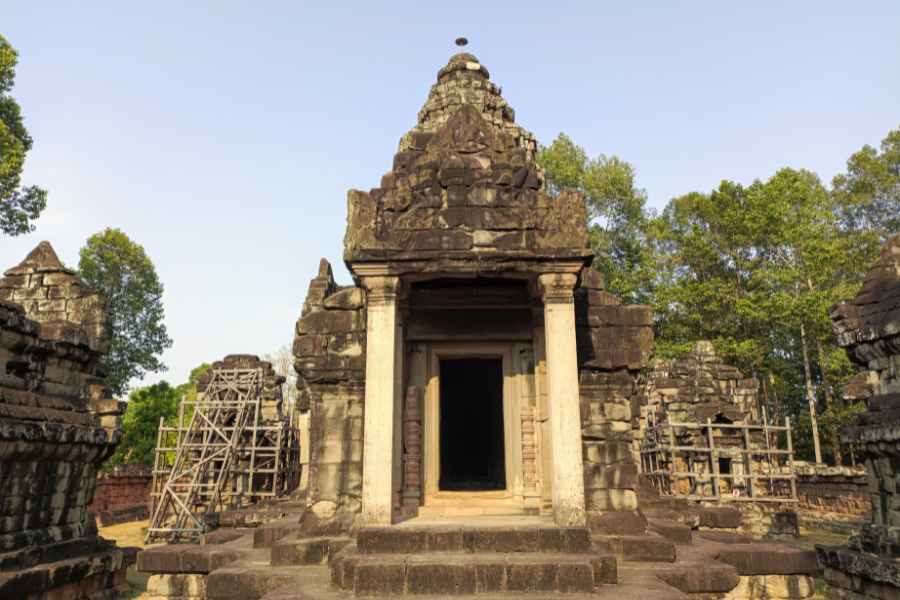
Etiquette in Buddhist Temples
When visiting Buddhist temples in Siem Reap, it is important to observe proper temple etiquette and behavior.
Temple etiquette and behavior
When visiting Buddhist temples in Siem Reap, it is important to be mindful of the following etiquette and behaviors:
- Dress modestly by covering your shoulders and knees. Wearing sleeveless tops, shorts, or mini-skirts is considered disrespectful.
- Remove your shoes before entering the temple grounds. It is customary to leave them outside or carry them with you in a bag.
- Avoid pointing your feet towards Buddha statues or monks, as it is considered rude. Instead, sit on your knees or cross-legged.
- Keep your voice low and speak softly inside the temple grounds to maintain a peaceful atmosphere.
- Ask for permission before taking photographs, especially if you want to capture images of monks or worshippers.
- Do not touch sacred objects within the temple unless instructed otherwise. Show respect by keeping a distance and refraining from any physical contact.
- Be aware of appropriate behavior during religious ceremonies. Follow the lead of locals and observe their actions to ensure you are acting appropriately.
- Avoid engaging in loud conversations or making excessive noise that could disturb others who are praying or meditating.
- Donate money or items only if you genuinely wish to contribute to the temple’s upkeep. However, it is essential to do so discreetly and without expecting anything in return.
Interacting with Buddhist monks
When visiting Siem Reap, it is important to understand how to appropriately interact with Buddhist monks. Monks hold a respected and revered position in Cambodian society, so it’s crucial to show them the proper respect.
When approaching a monk, remember to lower your head slightly as a sign of humility. It is also customary to use your right hand when giving or receiving something from a monk. Additionally, refrain from touching their robes or hair, as physical contact should be avoided.
By following these etiquette guidelines, you can ensure that your interactions with Buddhist monks in Siem Reap are respectful and culturally appropriate.

Cultural Customs and Practices
Respecting Cambodian customs and traditions is vital when visiting Siem Reap. From gift-giving etiquette to dining manners, understanding cultural practices will enhance your travel experience.
Respecting Cambodian customs and traditions
Cambodia is a country deeply rooted in its customs and traditions, and as a traveler, it is important to show respect for these cultural practices. One common tradition in Cambodia is the practice of bowing when greeting someone.
This gesture shows humility and respect. Additionally, addressing elders with the appropriate title such as “uncle” or “auntie” is highly regarded.
Another important aspect of Cambodian culture is gift-giving etiquette. When presenting a gift to someone, it is customary to use both hands as a sign of respect. It’s also worth noting that gifts are typically opened privately rather than in front of others.
Dining etiquette plays an integral role in Cambodian culture as well. Before eating, wait for the host or elder at the table to begin their meal before you do so yourself. Taking small portions and finishing food on your plate demonstrates appreciation for the meal and avoids waste.
Gift giving etiquette
Gift-giving is an important aspect of Cambodian culture, and knowing the proper etiquette is essential for travelers. Here are some key things to keep in mind when giving gifts in Siem Reap:
- Understand the symbolism: In Cambodia, gifts carry symbolic meaning. It’s important to choose a gift that reflects thoughtfulness and shows respect for the recipient. Popular choices include traditional handicrafts, artwork, or small souvenirs.
- Avoid expensive gifts: While it may be tempting to give lavish gifts, it is generally more appreciated to give modest and meaningful items. Cambodians value sincerity and thoughtfulness over the monetary value of a gift.
- Present gifts with two hands: When giving a gift, it is customary to use both hands as a sign of respect. This gesture shows that you are offering the gift with sincerity and humility.
- Receive gifts graciously: If someone presents you with a gift, it is polite to accept it graciously and express your appreciation. Even if the gift is not what you expected or wanted, it’s important to show gratitude for the gesture.
- Avoid wrapping gifts in white or black paper: In Cambodian culture, white and black are associated with mourning and death, respectively. It is best to avoid using these colors when wrapping gifts.
- Consider bringing gifts for children: If you plan on visiting local communities or interacting with children during your trip, small toys or school supplies can be great gifts that will be appreciated by both children and their families.
- Be mindful of religious beliefs: Cambodia has a strong Buddhist influence, so it’s important to consider cultural sensitivities when choosing a gift. For example, Buddhists do not wear shoes inside temples, so gifting shoes may be considered disrespectful.
Dining etiquette and table manners
When dining in Siem Reap, it’s important to be mindful of Cambodian dining etiquette and table manners. Here are some key tips to keep in mind:
- Wash your hands before eating.
- Wait for the host to invite you to sit down or begin eating.
- Use your right hand or a utensil (usually a spoon) to eat. It is considered rude to use your left hand.
- Do not use your fingers directly to pick up food, except for certain finger foods like spring rolls.
- Take small portions and try a bit of everything that is served.
- The oldest or most senior person at the table usually starts eating first as a sign of respect.
- Chew with your mouth closed and avoid making loud noises while eating.
- It is polite to finish all the food on your plate, as leaving food can be seen as wasteful.
- If you need more rice or another serving, ask politely by saying “soksabay” (excuse me) and pointing at what you want.
- Do not leave chopsticks sticking vertically into a bowl of rice, as it resembles incense sticks used in funerals.
- Wash your hands before eating.
- Wait for the host to invite you to sit down or begin eating.
- Use your right hand or a utensil (usually a spoon) to eat; avoid using your left hand.
- Avoid using your fingers directly unless for certain finger foods like spring rolls.
- Take small portions and try a bit of everything that is served.
- The oldest or most senior person at the table usually starts eating first as a sign of respect.
- Chew with your mouth closed and avoid making loud noises while eating.
- Finish all the food on your plate, as leaving food can be seen as wasteful.
- If you need more rice or another serving, ask politely by saying “soksabay” (excuse me) and pointing at what you want.
- Do not leave chopsticks sticking vertically into a bowl of rice.
Understanding and respecting the local customs and etiquette is vital for travelers visiting Siem Reap. From greetings to appropriate dress in temples, adhering to these cultural norms shows respect for Cambodian traditions.
By embracing these practices, visitors can fully immerse themselves in the rich heritage and history that Siem Reap has to offer while fostering positive interactions with locals. So remember, a little cultural sensitivity goes a long way when exploring this enchanting destination.
FAQs
What are some common greetings and gestures in Siem Reap?
Common greetings in Siem Reap include saying “chum reap suor” (hello) with a slight bow, placing your hands together in front of your chest as a sign of respect. It is also customary to remove your shoes before entering someone’s home or certain religious sites.
What should I wear when visiting temples in Siem Reap?
When visiting temples, it is important to dress modestly and respectfully. Both men and women should cover their shoulders and knees. Wearing loose-fitting clothes made from breathable fabrics like cotton is advisable to stay comfortable in the hot weather.
Are there any specific dining customs I should be aware of?
In Siem Reap, it is polite to wait for the host or the most senior person at the table to start eating before you begin. Use utensils rather than your hands unless you are eating finger foods specifically meant to be eaten that way.
Are there any cultural taboos I should avoid while in Siem Reap?
To show respect for local customs, avoid touching someone on the head as it is considered sacred, refrain from pointing at people or objects using your feet, and avoid displaying affection publicly as it may not be culturally appropriate.
Sources:
Recent Post
Get 30% Discount Now
Categories
Guided Tours

Private Siem Reap Airport SAI Transfers – Siem Reap Airport Pick-up or Drop-off, Just for You!
From: 30$
Shared SAI Siem Reap Airport Transfer – We depart every 1 hour!
From: 9$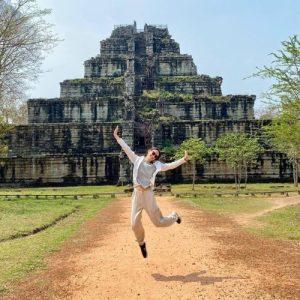
Private Full-Day Siem Reap to Koh Ker & Beng Mealea Temple Tour
From: 75$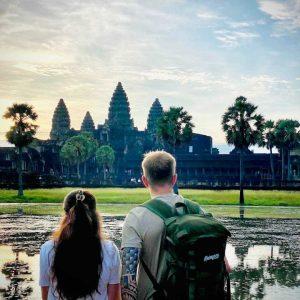
2-Day Angkor Wat Sunrise & Banteay Srei Grand Tour – Small Group Tours
From: 30$
2-Day Angkor Wat Temple Sunset and Floating Village Tour
From: 40$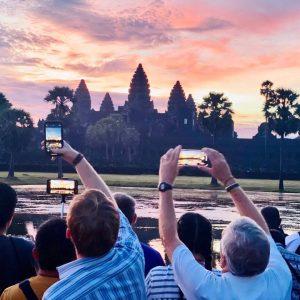
3-Day Angkor Wat Sunrise, Banteay Srei and Floating Villages Tour – Small Group Tours
From: 50$